Research - (2021) Volume 0, Issue 0
Ecological diagnosis of the marine environment of the Algerian West Coast using benthic macroalgae
I. Bouri1, O. Rouane-Hacene2* and Z. Boutiba1Abstract
The main objective of this study is to carry out an ecological diagnostic of intertidal rocky marine habitats on the Oran coastline (South Western Mediterranean). Ecological status and ecological quality were evaluated using the abundance and composition of benthic macroalgal to indicate changes in the aquatic ecosystem in nine (9) targeted stations. The floristic inventory has revealed a total of 18 taxa, including 5 Rhodophyta, 8 Phaeophyta, and 5 Chlorophyta. The calculation of environmental quality indices (average cover, global average cover and species richness) showed a heterogeneity in the composition and the distribution of macroalgae between the different stations, as well as a very high diversity at the station (S1), which was characterized by the presence of fourteen (14) algae species of algae of the three groups compared to the other stations. The algal flora of Oran Bay was characterized by the dominance of Chlorophyta, followed by Phaeophyta and Rhodophyta.
Keywords
Biodiversity, Biotic indices, Intertidal zone, Macroalgae, Oran coastline.
Introduction
Coastal marine ecosystems are environments that are increasingly affected by human activity. Industrialization and the development of cities and human societies in the coastal zone are the main causes of the increase in ecological pressure on these environments. However, Algerian coasts are not spared from this pollution. In fact, several studies have demonstrated the impact of anthropogenic activities on Algerian coastal ecosystems (Rouane Hacene et al., 2016; 2018; Benaissa et al., 2017; Rouabhi et al., 2019). However, in order to counteract the degradation of natural marine environments, it is essential to develop tools for assessing and monitoring the quality of the marine environment (Pinedo et al., 2007; Bélanger, 2009). Thus, over the past few decades, the science of bioindication has been developed. The latter is based on the use of living organisms to assess the environmental conditions of a given environment, using numerous tools (bioindicators, biomonitors, bioaccumulators, biomarkers, etc.) and allowing the management and maintenance of coastal marine ecosystems. Among the various bioindicators, seaweeds can be used to assess the quality of the marine environment. These sessile organisms provide a local picture of contamination. Furthermore, they are sensitive to disturbances in the water column and sediments (Garca-Seoane et al., 2018). Benthic macroalgae are very good bioindicators of water quality in marine ecosystems (Borowitzka, 1972; Munda, 1974; Littler and Murray, 1975; Murray and Littler, 1978; Belsher, 1979; Levine, 1984; Kautskyl et al., 1986; Philips, 1994; Perez et al., 2000). They have the capacity to bioaccumulate various pollutants, including heavy metals (Leal et al., 1997; Haury et al., 2000; Villares et al., 2001; Lauret et al., 2011). They can therefore be used to assess different types of contaminants in aquatic environments. Their stand dynamics are strongly influenced by the seasons (Lauret et al., 2011), the biotope, abiotic environmental conditions (Augier and Boudouresque, 1971; Selosse, 2000) and pollution (Manneville, 2006). Through the structure of benthic stands and the organization of species within these stands, it is possible to assess the overall quality of the environment through structural bioindices (Bellan, 1984; Grimes, 2003). Indeed, biodiversity has long been regarded as mere inventories of biological diversity. Biodiversity is increasingly included in environmental assessments through the use of indicators for pollution detection and nature protection work (Grimes, 2003). The diversity of seaweed in the Mediterranean is still not completely known, especially in some areas of its African coasts (Ould-Ahmed et al., 2019). The first inventories of benthic marine algae in Algeria are essentially due to the work of Montagne (1856) and Debray (1893, 1897). Subsequently, research by (Feldmann, 1954; Feldmann and Feldman, 1964; Lawson and John, 1977) confirmed their findings and constitute the bulk of recent knowledge on algal flora (Boudouresque, 1984). However, no studies have been carried out on the algal diversity along the Oran coast, especially in recent years.
The present study was conducted to establish an inventory of macroalgae inhabiting the intertidal zone, to: (i). Determine the geographical distribution of benthic macroalgae at the level of the Oran Bay (ii). Select the most representative species of this area, applying the methodology adopted for the study of the phycoflora of this coastline. (iii). Establish an ecological diagnosis by performing a global analysis of the phytobenthos by comparing analytical and synthetic parameters.
Materials and Methods
Description of sampling area
Monitoring benthic macroalgae of the mid-littoral stage of the Oran coastline during the autumn season has targeted nine sites (S1-S9), they are indicated on the map (Fig. 1). Their choice is based on; the importance of the algal flora and the ease of access and work to ensure a representative sampling and the quality of the study site as a function of distance and proximity to pollution sources.
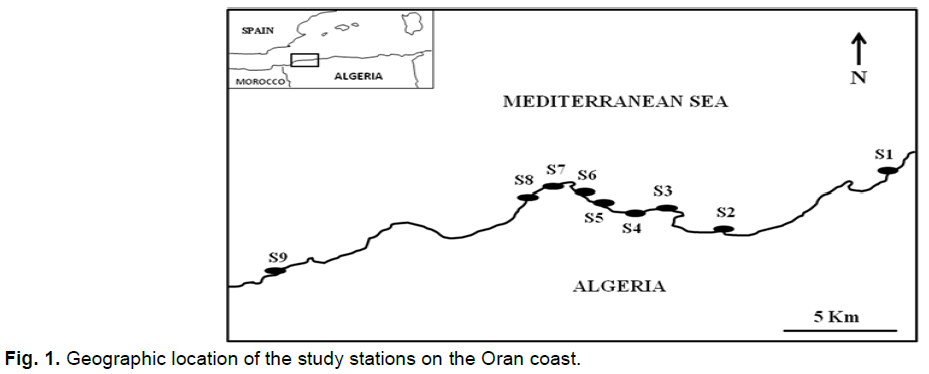
Fig 1. Geographic location of the study stations on the Oran coast.
Sampling methods
To calculate the recovery rate of each species in an algal belt, a 25 cm × 25 cm PVC quadrat was used (Waern, 1952; Molinier and Piacard, 1952; Harmelin and True, 1964; Boudouresque, 1967,1974). Nine (9) surveys were conducted at each site and geo-referenced using a GPS. . Algae not identified on site were collected, preserved in seawater and 5% formalin (Harmelin and True, 1964), and transported to the laboratory. The algae are examined in the laboratory, under a binocular magnifying glass and/or an optical microscope. The identification of species sampled was based on the characteristics of structure and growth (sometimes observable with a magnifying glass) and cytology or reproduction, which can only be properly analysed under the microscope.
Principal component analyses
The statistical method we have adopted for this study is principal component analysis (PCA). This method focuses on the correlation analysis of the variables. Statistical analysis was performed using STATISTICA software STATISTICA (version 12.5.192.7).
Results
The inventory allowed the identification of 18 (18) species of marine benthic macroalgae, including eight (8) species of the Phaeophyta group, five (5) species belonging to the Rhodophyta group and five (5) species of the Chlorophyta group, out of eighty-one (81) surveys carried out at the nine (9) targeted sites in the Bay of Oran. The complete list of species identified from the intertidal is given in (Table 1). The global average cover of the three (3) benthic macroalgal species calculated at the target sites are shown in (Fig. 2). Global average cover of the three (3) benthic macroalgal groups calculated at the target sites are shown in (Fig. 3). The species richness of the three (3) benthic macroalgal groups calculated in the target sites are shown in (Fig. 4). The total average cover for each species of benthic macroalgae present at the stations is shown in (Fig. 5).
| Chlorophyta | Rhodophyta | Phaeophyta |
|---|---|---|
| Chaetomorpha aerea Chaetomorpha linum Enteromorpha linza (Ulva linza) Ulva lactuca Valonia macrophysa |
Asparagopsis armata Corallina elongata Halopithys incurva Halopithys musciformis Jania rubens |
Cystoseira compressa Cystoseira tamariscifolia Dictyota dichotoma Dilophus spiralis Padina pavonica Sargassum acinarium Scytosiphon lomentaria Petalonia fascia |
Table 1. Florestic inventory of benthic macroalgae of the nine stations, all the species listed are mentioned in the following table.
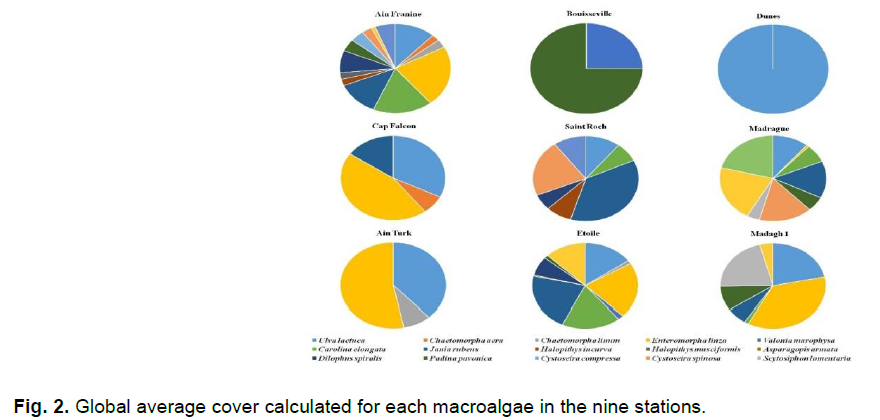
Fig 2. Global average cover calculated for each macroalgae in the nine stations.
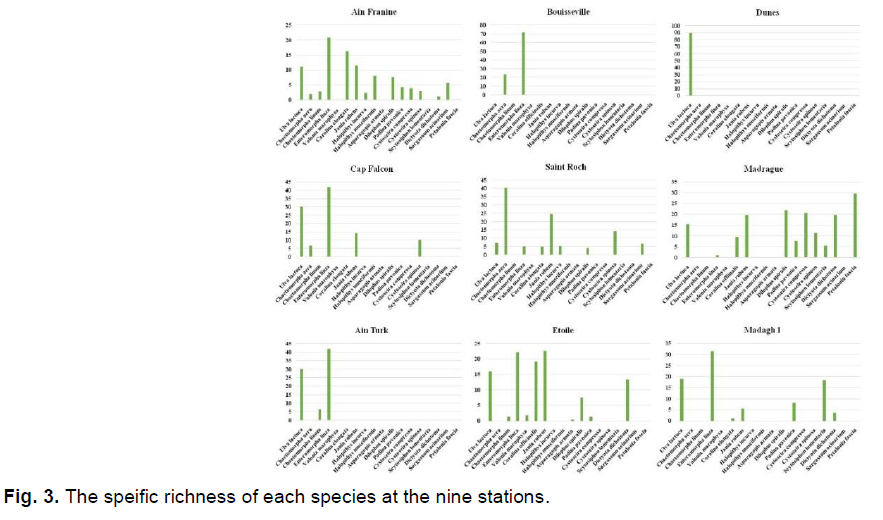
Fig 3. The speific richness of each species at the nine stations.
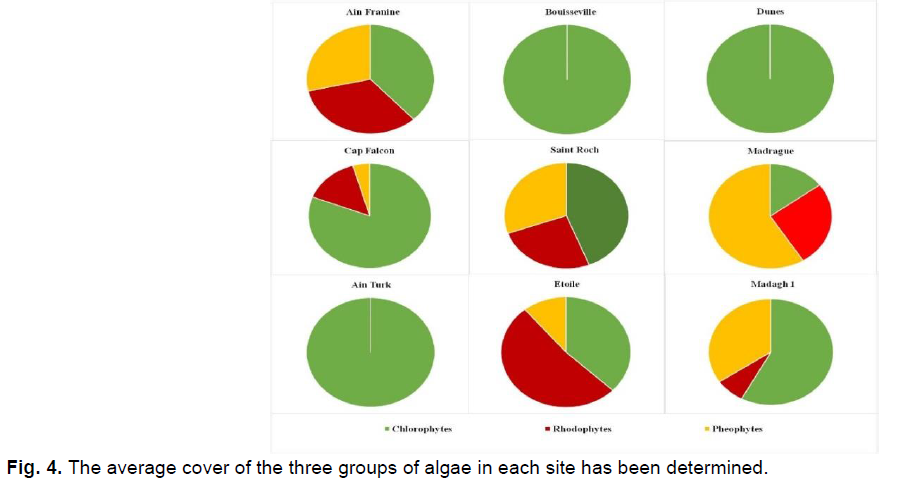
Fig 4. The average cover of the three groups of algae in each site has been determined.
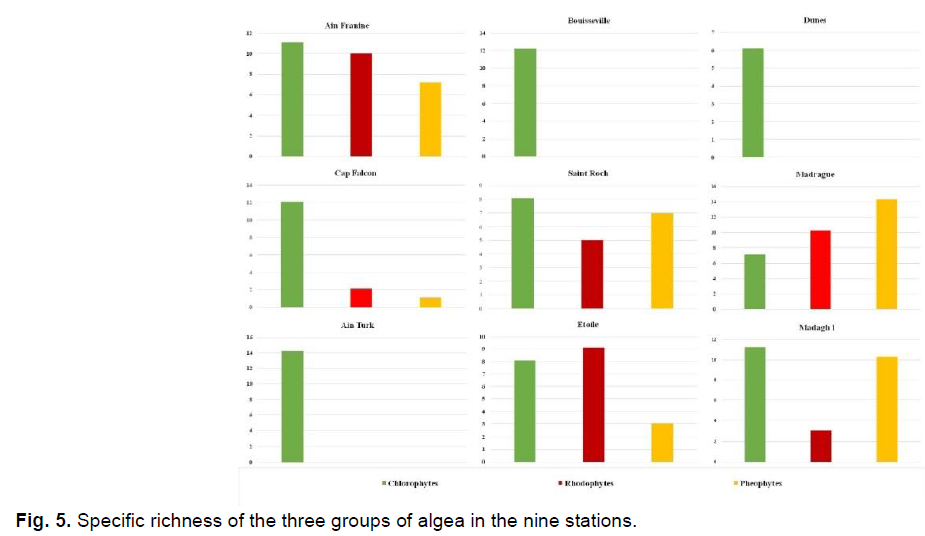
Fig 5. Specific richness of the three groups of algea in the nine stations.
The calculation of the average cover, global average cover and species richness reported the presence of the three (3) algal groups at six (6) stations (S1, S2, S5, S6, S7 and S9) with a wide range of richness percentages.
The most dominant species in three (3) sites is Enteromorpha linza (Ulva linza) with a total average cover of 22% to 72%. Chaetomorpha aera, the most dominant species at station S2, while at station S7 a dominance of the Rhodophyta group was remarkable, with an average cover of 204% and a total average cover of about 23% for the Jania rubens species.
Station S6 shows a species richness favorable to the Phaeophyta group; Their total average cover was very high compared to the other two groups and the highest average cover was that of the Petalonia fascia.
Stations S3, S4 and S8 were characterized by the presence of the chlorophyta group only and a dominant Enteromorpha linza (Ulva linza) at stations S3 and S4 and Ulva lactuca at station S8.
The results of the distribution of the different species of algae were integrated into a multivariate analysis to detect patterns of variation. The results of the principal component analysis (PCA) indicated that the two principal components accounted for 95.00% of the total variance (PC1=30.26%; PC2=21.46%) (Fig. 6a). The study of the correlation between species revealed a rather varied distribution of benthic macroalgae with a very significant correlation between brown red algae. Petalonia fascia, Dictyota dichotoma, Dilophus spiralis, Cystoseira compressa, Scytosiphon lomentaria, and Padina pavonica. These species form a homogeneous and distinct group with very high correlation factors that vary between 0.80 and 0.98. The results also indicate a very significant correlation between the brown alga Sargassum acinarium and the red alga Halopithys incurva (R=0.94).
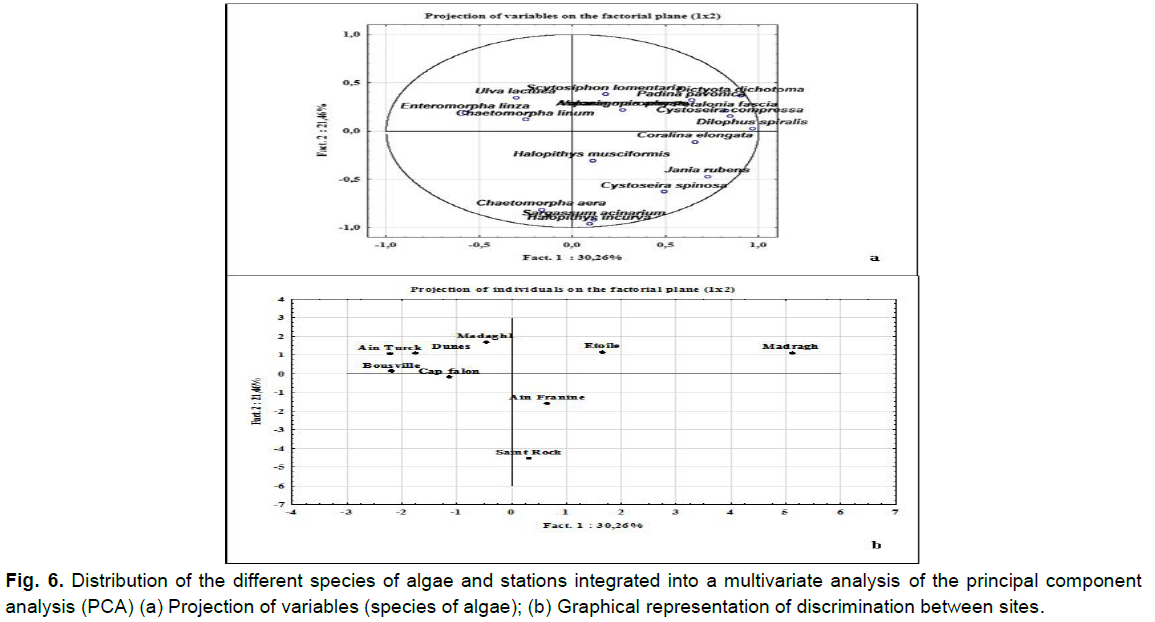
Fig 6. Distribution of the different species of algae and stations integrated into a multivariate analysis of the principal component analysis (PCA) (a) Projection of variables (species of algae); (b) Graphical representation of discrimination between sites.
The three algae Ulva lactuca, Chaetomorpha linum, and Enteromorpha linza (Ulva linza) form a distinct group, indicating their distributions and ecological habitat specific to green algae.
The representation in Fig. 6b clearly separates the sites of Madragh, Ain Turck, Dunes, Bousville, and Cap falon. We also notice that the site of Ain Franine is grouped with Saint Rock, and Etoile with Madragh.
Discussion
Pollution of the sea, 80% of which comes from land-based human activities, shipping, the introduction of invasive species, overexploitation of fishery resources, degradation, fragmentation, and loss of habitats are all factors responsible for the erosion of marine biodiversity. Exacerbated by climate change, this anthropization threatens to destroy the fragile balance of marine ecosystems and the biodiversity they contain (Amara, 2010). In recent years, pollution in coastal areas has become increasingly important at all environmental, health, and economic levels (Harrison et al., 2014). In these different ecosystems, pollutants cause disturbances to living beings (fauna and fauna) and basic abiotic compartments (Merzouk, 2016; Chabane et al., 2018; Belhaouari and Bezzina, 2019). Several studies along the western Algerian coast have reported the same findings that confirm the impact of urban and agricultural wastewater discharges (Rouane Hacene et al., 2015; Benaissa et al., 2017; Rouabhi et al., 2019) and effluents from industrial units and desalination plants (Benaissa et al., 2017; Rouane Hacene et al., 2018). Different approaches are possible to assess the exposure and/or biological effects of pollutants emitted in a given ecosystem (Harrison et al., 2014). A distinction can be made between in situ studies, direct, using plant or animal organisms collected on site (passive bioindication), or indirect, using animals or plants transferred to the site (active bioindication), and experimental or bioassay models, in which living species are exposed in the laboratory to samples taken from a site (Harrison et al., 2014). Among the living marine organisms used in the biomonitoring of aquatic environments, macroalgae have been extensively tested for contamination of estuarine and marine waters (Vasquez and Guerra, 1996).
Macroalgea have been widely used as excellent biomonitors (Haug et al., 1974; Phillips, 1990; Meinesz et al., 2011) due to: the majority of them are sessile; they are widely distributed and accessible throughout the year; they can withstand large areas of salinity, turbidity, and high levels of contamination; and they can be maintained under research centre conditions (Phillips, 1977; Levine, 1984; Maeda and Sakaguchi, 1990; Vasquez and Guerra, 1996; Farias et al., 2018).
Benthic macroalgae have been used in biomonitoring since the 1950s, although the standard protocol that would allow widespread implementation of the technique has not yet been developed yet (García-Seoane et al., 2018).
The use of community parameters has an important role to play in understanding the understanding of emission disturbances in marine life. Of these, diversity indices were most commonly used with varying degrees of success (Littler and Murray, 1975; Belsher, 1979).
Many previous research has also found that descriptive statistics are an excellent means of describing the number of species detected per sample, the abundance of individual species and biomass, and then summarizing this information as measures of species diversity and richness. If the community is affected by pollution, the competitive balance will be disturbed and the diversity of species diversity will change. (Breugnot et al., 2008)
The present study focused on the distribution of benthic macroalgae along the coast of Oran during the fall season and from a total of eighty-one (81) surveys identified 18 (18) species of macrophytes belonging to the mediolittoral (intertidal zone) stage, of which five (5) species represent the Chlorophyta group, five (5) species belong to the Rhodophyta group, and seven (8) species to the Phaeophyta group.
The current analysis of the distribution of benthic macroalgae on the Oran coast and in the nine (9) target stations shows that the distribution of the three algae groups was heterogeneous. The presence of the three classes (green, red, and brown) was noted at six (6) sites with varying proportions.
Ain Franine (S1) is the most diverse station, the species richness was high (maximum) for the three groups of algae. A total of 14 species were inventoried, but the average cover was most remarkable, the overall recovery rate of the species showed a dominance for the green alga Enteromorpha liza (Ulva linza).
On the other hand, the two Madagh1 (S9) and la Madragh (S8) stations have a lower algal diversity, with a specific richness favorable to brown algae at the Madragh (S8), compared to the other two groups.
The dominant species is Petalonia fascia. A high species richness of chlorophyceae was recorded at the Madagh1 station Madagh1 (S9) which was characterized by a high average cover and a high global average cover for Enteromorpha liza (Ulva linza).
Concerning the stations : Saint Rock (S2), Cap Falcon (S5), and Etoile (S7), the species richness (Q) was more or less the same for the three groups of algae, but the average coverage and global average coverage were low compared to the previous sites; Algal diversity was medium. The first two stations were characterised by a dominance of the Chlorophyceae group, with a very favorable average coverage for the species Enteromorpha linza (Ulva linza) at Cape Falcon and Chaetomorpha aera at Saint Rock (S2), while the 'Etoile' site is caraterized by a dominan of the Rhodophyceae group, its specific richness was very remarkable compared to the other groups, the dominant species and the red alga Jania rubens.
The Enteromorpha linza (Ulva linza) species was dominant at sites S3 and S4. In fact, this result is probably linked to pollution due to anthropogenic activity (wastewater). Although Ulva lactuca is the only species present at the third site S8, there is a desalination plant with a capacity of 500 m3/d that discharges a significant amount of salt.
The study of the correlation between species revealed a rather varied distribution of benthic macroalgae with a very significant correlation between brown algae :- Petalonia fascia, Dictyota dichotoma, Dilophus spiralis, Cystoseira compressa, Scytosiphon lomentaria, and Padina pavonica. These species had very high correlation factors. The results also indicate a very significant correlation between the brown alga Sargassum acinarium and the red alga Halopithys incurva. The three algae Ulva lactuca, Chaetomorpha linum, and Enteromorha linza (Ulva linza) form a distinct group, indicating their distributions and ecological habitat specific to green algae.
In this western zone of the Algerian coastline, the maximum specific richness is observed in the stations far from wastewater discharges. However, polluted stations are characterized by the abundance of Ulva and Chaetomorpha and generally the absence of phaeophyta. These results corroborate several previous studies that confirm the dominance of green algae in highly disturbed environments and near freshwater inputs, such as Ulva (Bellan and Bellan, 1972) or Enteromorpha (Kadari–Meziane, 1994; Bouiadjra, 2012). Other studies on the effect of wastewater discharges and other sources of pollution on macroalgae indicate a marked sensitivity of brown algae (Soltan et al., 2001). Overall, this study of the distribution of benthic macroalgae along the Oran coast shows that the use of analytical and synthetic parameters reflects a certain imbalance in the populations in the mid-littoral zone throughout the targeted stations. These results support several previous work (Boudouresque, 1971; Borowikza, 1972; Munda, 1974; Littler and Muray, 1975; Phillips, 1977; Belsher, 1977, 1979; Levine, 1984; Boudouresque, 1984; Kautsky et al., 1986; Perez et al., 2000; Seridi et al., 2007). The overlap indices indicate the quality of each station studied, implying that these macrophytes are excellent indicators and can be used as bioindicators of the quality of marine ecosystems (Perez, 2000). In fact, the life and distribution of algae on marine shores depend on a whole set of factors that are very different from those that condition the existence of terrestrial plants (Garca-Seoane et al., 2018). Indeed, macroalgae are distributed essentially according to the availability of the substrate, hydrodynamic conditions, the degree of immersion that organizes them into belts, and the amount of light. Variations in environmental, physical, or chemical factors, such as illumination, acidification, and increases or decreases in temperature and/or nutrient levels, profoundly modify the composition of communities (Nauleau, 1988).
The distribution of algae in ocean basins is limited to shallow rocky environments where they find sufficient light to support photosynthesis and a stable substrate to attach to (Tamigneaux and Ladd, 2016). Some species with fragile or very long thallus are shredded or torn from the substrate by strong waves, while others require highly oxygenated, wave- and current-battered water to survive. Calm coastlines are more prone to siltation, whereas battered coastlines are rocky or sandy (Selosse, 2000). In addition, rainfall or strong sunshine in the upper mediolittoral and supralittoral regions cause the salt content of the algae living there to vary greatly (Augier and Boudouresque, 1971).
Areas with variable salinity limit the adaptation of algae. This instability disrupts metabolism, sometimes to the point of species elimination. Only green algae are resistant to harsh conditions; in some areas, either muddy and brackish or rich in nitrates, green algae (especially Ulva latuca and Enteromorpha linza (Ulva linza)) can be seen from afar, especially from spring to summer; they grow very fast, are resistant to emersion, and break off easily to accumulate on top of beaches to form "green tides" (Manneville, 2006).
According to Mallefet (2008), the color of thallus does not always correspond to the nature of chloroplastic pigments, which allow the algae to be attached to a group. The presence of many other pigments (carotene, xanthophyll, etc.) in variable quantities can be misleading, not to mention the calcareous incrustations that can mask the colours of the key pigments (Lauret, 2011). This was confirmed by identifying the Halopithys musciformis which presents a green thallus, but belongs to the Rhodophyta group.
Our inventory carried out on the Oran coast confirms the absence of Laminariales and the rarity of Fucales; the genus Cystoseira was widely present at the sites : Ain Franine, Madragh, and Madagh1 and represented by two species tamariscifolia and compressa. According to Boudouresque (1971), the Mediterranean algal flora is characterised by the size of the species, which is relatively small compared to cold regions. It is characterised by a rarity of Laminariales compared to that of the Atlantic. Fucales are represented by a small number of genera. On the Cystoseira other hand, the genus constitutes a major element of Mediterranean phytosociology.
Conclusion
The present study shows that the composition, abundance, and distributtion of macroalgae of the Oran coast area reflect an inherent spatial heterogeneity in benthic systems. In the nine targeted stations, 18 taxa were identified, their environmental quality indices (average cover,, global average cover and species richness) calculated are varied from one species to another at the same site and from one site to another. The ecological status and conditions were very different, which explains the absence and or presence of certain species in this coastal zone.
The study of the correlation between species revealed a rather varied distribution of benthic macroalgae with a very significant correlation between brown algae :- Petalonia fascia, Dictyota dichotoma, Dilophus spiralis, Cystoseira compressa, Scytosiphon lomentaria, and Padina pavonica. The results also indicate a very significant correlation between the brown alga Sargassum acinarium and the red alga Halopithys incurva.
The three algae Ulva lactuca, Chaetomorpha linum, and Enteromorpha linza (Ulva linza) form a distinct group, indicating their distributions and ecological habitat specific to green algae.
The results have clearly confirmed several previous studies that have prouved that environmental quality indices provide an excellent tool for using macroalgae coastal communities for ecological quality assessment.
The studies of phytobenthos by Boudouresque et al., 1984; Seridi et al., 2007 have shown that the composition of the Western Mediterranean algal flora is characterised by the total absence of the genus belonging to the family Laminariales, the rarity of the genus Fucales, on the other hand an abundance of the genus Cystoseira especially at sites with little or no pollution. The presence of certain taxa indicates the good health of the benthic ecosystem, as in the case of the brown algae Cystoseira compressa. On the other hand, other species testify to the poor quality of the environment, such as Enteromorpha linza (Ulva linza), whose avarege cover was high at the Bouissville site and Ulva lactuca at the Dunes site.
Acknowledgments
This research study is supported and funded by the Directorate General for Scientific Research and Technological Development (DGRSDT). This article is dedicated to Pr. Zitouni Boutiba
References
Amara, R. (2010). Impact of anthropization on biodiversity and the functioning of marine ecosystem. The Electronic Journal of Environmental Sciences,pp:1492-8442.
Augier, H., Boudouresque, C.F. (1971). Concepts of marine eco-bioenotics:excursions in the Mediterranean, Regional Centre for Educational Documentation Marseille, p:109.
Bélanger, D. (2009). Use of macrobenthic fauna as a bio-indicator of the quality of the coastal marine environment. MSc Thesis. Faculty of science. University of sherbrooke. Sherbrooke, Québec, Canada.
Bellan, G. (1984). Other title biological indicators and indexes in the marine field. Ecology Newsletter, 15:13-20.
Bellan, G., Bellan-Santini, D. (1972). Influence of pollution on marine settlements in the Marseille area. Marine Pollution and Sea Life. Mediterranean Marine Ecosystems Springer US, pp:396-401.
Belhaouari, B., Bezzina, Z. (2019). Study of the macroalgae and application of ecological evaluation index (EEI-c) in the coastal waters of Algeria. Aquatic Biology, 7:254-259.
Belhaouari, B., Rouane-Hacene, O., Bendaha, M., Zitouni, B. (2014). Effects of metal sulphates on catalase and glutathione-s-transferase of marine gastropod : Osilinus turbinatus. Journal of Applied Environmental and Biological Sciences, 4:191-196.
Belsher, T. (1977). Analysis of the repercussions of urban pollution on the Mediterranean macrophytobenthos (Marseille, Port-Vendres, Port-Cros). Doctoral thesis. Aix-Marseille University. France.
Belsher, T. (1979). Pollution index definition test, Mediterranean Sea. International Explosure Science Mediterranean Rapprt, 4:25-26.
Benaissa, M., Rouane-Hacene, O., Boutiba, Z., Guibbolini-Sabatier, M., Risso-de Faverney, C. (2017). Ecotoxicological impact assessment of the brine discharges from a desalination plant in the marine waters of the Algerian west coast, using a multibiomarker approach in a limpet, Patella rustica. Environmental Sciences Pollution Research,pp:1-12 .
Borowitzka, M.A. (1972). Intertidal algal species diversity and the effect of pollution. Freshwater Resources, 23:73-84.
Boudouresque, C.F. (1967). Contribution to the phytosociological study of the algae populations of the Var coasts. Végétation Nether, 22 (1-3), 84-184.
Boudouresque, C.F. (1971). Qualitative and quantitative study methods for Benthos (in particular the phytobenthos). Tethys, 3:79-104.
Boudouresque, C.F. (1974). Minimum area and marine algae stands.Phycological Society, pp:141-157.
Boudouresque, C.F. (1984). Ecological groups of marine algae and benthic phytocenoses in the Mediterranean Sea. Giornale Botanico Italiano, 118:7-42.
Boudouresque, C.F. (1996). Human impact and conservation of the environment in the Mediterranean. Publisher: GIS Posidonie 2nd Edition, France, pp:241- 243.
Bouiadjra Benabdallah, B. (2012). The study of the benthic algal flora and the impacts of its invasive species in front of the Mostaganem coast. Thesis Doctorate. Abdelhamid Ibn Badis Mostaganem University.
Breugnot, E., Dutartre, A., Laplace-Treyture, C., Haury, J. (2008). Local distribution of macrophytes and consequences for sampling methods in large river. Hydrobiologia, 610:13-23.
Chabane, K., Bahbah, L., Séridi, H. (2018). Ecological quality status of the Algiers coastal waters by using macroalgae assemblages as bioindicators (Algeria, Mediterranean Sea). Mediterranean Marine Science, 19:305-315.
D’Adamo, R., Di Stasio, M., Fabbrochini, A. (2008). Migratory crustaceans as biomonitors of metal pollution in their nursery areas, The Lesina lagoon (SE Italy) as a case study. Evironmental Monitoring and Assessment, 143:15-24.
Debray, F. (1893). List of marine and freshwater algae harvested to date in Algeria. Scientific Bulletin of France and Belgium, 25:1-19.
Farias, D.R., Hurd, C.L., Eriksen, R.S., Macleod, C.K. (2018). Macrophytes as bioindicators of heavy metal pollution in estuarine and coastal environments. Marine Pollution Bulletin, 128:175-184.
Feldmann, J. (1954). Inventory of marine flora in Roscoff. Travel Statistic Biology, 6:151-152.
Feldmann, J., Magne, M.F. (1964). Additions to the inventory of Roscoff's marine flora:algae, fungi, lichens. Works Roscoff Biological Station, 15:1-23.
García-Seoane, R., Fernández, J.A., Villares, R., Aboal, J.R. (2018). Use of macroalgae to biomonitor pollutants in coastal waters:Optimization of the methodology. Ecological Indicators, 84:710-726.
Grimes, S. (2003). Assessment and national diagnosis of the marine pollution of the Algerian coast related to activities carried out on land, Strategic Action Programme (SAP) to combat Inventory of Roscoff's marine flora, work of the Roscoff Biological Station.
Harrison, P.J., Hurd, C.L., Bischof, K., Lobban, C.S. (2014). Pollution, seaweed ecology and physiology. Cambridge University Press, Cambridge, United Kingdom, pp:374-412.
Harmelin, J.C., True, M.A. (1964). Cartographic limitation of the current extension Posidonia oceanica (Delille) meadows in the Gulf of Marseille. Recl Tray Stn Mar Endoume, 34:157-160.
Haury, J., Peltre, M.C., Muller, S., Thiébaut, G., Trémolières, M., Demars, B., Barbe, J., Dutartre, A., Guerlesquin M., Lambert, E. (2000). Aquatic macrophytes as bioindicators of lotic systems-Interests and limits of macrophytic indices. Bibliographical synthesis of the main European approaches for the biological diagnosis of watercourses. UMR INRA-ENSA EQHC Rennes and Phytoecologie Univ. Metz. Agence de l'Eau Artois-Picardie, Etudes sur l'Eau en France.
Kadari-Meziane, Y. (1994). Contribution to the study of the impact of pollution on the spatio-temporal distribution of phytobenthic stands in the bay of Bou-Ismail (Algeria).
Kautskyl, N., Kautskyl, H., Kautskyl, U., Waern, M. (1986). Decreased depth penetration of Fucus vesiculosus (L.) since the 1940's indicates eutrophication of the Baltic Sea. Marine Ecology Progress Series 28:1-8.
Lauret, M., Oheix, J., Derolez, V., Laugier, T. (2011). Guide to the recognition and monitoring of lagoon macrophytes in Languedoc-Roussillon, Lagoon Monitoring Network, Ifremer,p:148.
Leal, M.C.F., Vasconcelos, M.T., Sousa-pinto, I., Cabral, J.P.S. (1997). Biomonitoring with benthic macroalgae and direct assay of heavy metals in seawater of the Oporto coast (northwest Portugal). Marine Pollution Bulletin 34:1006-1015.
Lawson, G.W., John, D.M. (1977). The marine flora of the Cap Blanc peninsula: its distribution and affinities. Botanical Journal of the Linnean Society, 75:99-118.
Levine, H.G. (1984). The use of seaweeds for monitoring coastal waters, (E. Shubert, Éd.) Algae as Ecological Indicators. Academic Press, 20:189-210.
Littler, M.M., Murray, S.N. (1975). Impact of sewage on the distribution, abundance and community structure of rocky intertidal macro-organisms. Marine Biology, 30:277-291.
Maeda, S., Sakaguchi, T. (1990). Accumulation and detoxification of toxic metal elements by alga, In: Akatsuka I (ed.) Introduction to applied phycology, Academic Publishing, pp:109-113.
Mallefet, J. (2000). Impact of an extract of brown algae "Ascophyllum nodosum" and "Fucus vesiculosus" on glucose homeostasis in overweight/obese prediabetic subjects.Extract from the quarterly review "Hippocampe" n° 177-September Official journal of the Ligue Francophone of Research and Underwater Activities, France.
Manneville, J. (2006). Contribution to the synusial study of the coastal vegetations of marine macroalgae of the French Atlantic coasts. Acta Botanica Gallica, 153:219-234.
Meinesz, A., Boudouresque, C.F., Falcontti, C., Astier, J.M., Bay, D., Blanc, J.J., Bourcier, M., Cinelli, F., Cirik, S., Cristiani, G., Geronimo, I.D.J., Giaccone, G., Harmelin, J.G., Laubier, L., Lovric, A.Z., Molinier, R., Soyer, J., Merzouk, A., Johnson, L.E. (2011). Kelp distribution in the northwest Atlantic Ocean under a changing climate. Journal of Experimental Marine Biology and Ecology, 400:90-98.
Merzouk, A. (2016). State of knowledge of seagrass beds and portrait of algal resources on Quebec's coasts. Final Report.Merinov, p:137.
Molinier, R., Picard, J. (1951). Biology of the Zosteraeaea meadows of the French Mediterranean coasts. C.r. hebd. Seanc. Academyof Sciences, 233:12-14.
Molinier, R., Picard, J. (1952). Research on seagrass beds on the French Mediterranean coast. Annals of the Institute of Oceanography, 27:157-234.
Molinier, R. (1960). Study of the marine biocenosis of Cape Corsica. Vegetatio, 9:3-5.
Montagne, C. (1856). Sylloge generum specierumque cryptogamarum. J.B Bailliere Edit., Paris.
Murray, S.N., Littler, M.M. (1978). Patterns of algal succession in a pertubated marine intertidal community. Journal of Phycology, 14:506–512.
Munda, I.M. (1974). Changes and succession in the benthic algal associations of slightly polluted habitats. International Journal of Medical Oceanography, 34:37-52.
Nauleau, O. (1988). Bibliographical analysis of the conditions of development of colonial algae with macroscopic formations, Study report of the SRAE Franche Comité on behalf of the Rhone-Mediterranean Corsica Water Agency., Lyon, p:25.
Ould-Ahmed, N, Gomez, Garreta, A., Ribera Siguan, M-A. (2019). Checklist of the benthic marine macroalgae from Algeria, part II: Ulvophyceae. Anales del Jardín Botánico de Madrid,p:76.
Pinedo, S., García, M., Satta, M.P., Torres, M., Bellesteros, E. (2007). Rocky-shore communities as indicators of water quality: A case study in the Northwestern Mediterranean. Marine Pollution Bulletin, 55:126-135.
Perez, T., Garrabou, J., Sartoretto, S., Harmelin, J.G., Francour, P., Vacelet, J. (2000). Mass mortality of marine invertebrates: an unprecedented event in the north-western Mediterranean, Academy of Sciences, Scientific and medical Elsevier SAS,323:853-865.
Phillips, D.J.H. (1977). The use of biological indicator organisms to monitor trace metal pollution in marine and estuarine environments. Environmental Pollution, 13:281-317.
Phillips, D.J.H. (1990). Use of macroalgae and invertebrates as monitors of metal levels in estuaries and coastal water, In Heavy Metals in the Marine Environment, CRCPRESS Boca Raton, pp:81-99.
Philips, D.J.H. (1994). Macrophytes as biomonitors of trace metals in biomonotoring of coastal Waters and Estuaires. CRC Press, Boca Raton FL., pp:85-103.
Rouabhi, Y.L., Philippe Grosjean, P., Boutiba, Z., Rouane Hacene, O., Richir, J. (2019). Reproductive cycle and follicle cleaning process of Mytilus galloprovincialis (Mollusca : Bivalvia) from a polluted coastal site in Algeria. Invertebrate Reproduction and Development, 63:255-267.
Rouane-Hacene, O., Boutiba, Z., Belhaouaria, B., Guibbolini-Sabatier, E., Francour, P., Risso-de Faverney, C. (2015). Seasonal assessment of biological indices, bioaccumulation and bioavailability of heavy metals in mussels Mytilus galloprovincialis from Algerian west coast, applied to environmental monitoring. Oceanologia, 57:362-374.
Rouane-Hacene, O., Benaissa, M., Boutiba, Z., Belhaouaria, B., Guibbolini-Sabatier, M., Francour, P., Risso-de Faverney, C. (2018). Seasonal assessment of biological indices, bioaccumulation and bioavailability of heavy metals in sea urchins Paracentrotus lividus from Algerian west coast, applied to environmental monitoring. Environmental Science and Pollution Research, 25:11238-11251.
Selosse, M.A. (2000). An example of algal-invertebrate symbiosis in Belle-Isle-en-Mer: the planar Convoluta roscoffensisand the prasinophyceaeTetraselmis convolutae. Acta Botanica Gallica,147:323–331.
Soltan, D., Verlaque, M., Boudouresque, C.F., Francour, P. (2001). Changes in macroalgal communities in the vicinity of a mediterranean sewage outfall after the setting up of treatment plant, Marine Pollution Bulttin, 42:59-70.
Tamigneaux, É., Johnson, L.E. (2016). Saint Lawrence macroalgae: an essential component of unique marine ecosystem and a precious natural resource in a context of global change. The Canadian Naturalist,140:6.
Vasquez, J.A., Guerra, N. (1996). The use of seaweeds as bioindicators of natural and anthropogenic contaminants in northern Chile, Hydrobiologia, 326:327- 333.
Villares, R., Puente, X., Carballeira, A. (2001). Ulva and Enteromorpha as indicators of heavy metal pollution, Hydrobiologia, 462:221-232.
Waern, M. (1952). Rocky-shore algae in oregrund archipelago, Acta Physio Geogr, 30:291-298.
Author Info
I. Bouri1, O. Rouane-Hacene2* and Z. Boutiba12Department of Biology, University of Oran 1 Ahmed Ben Bella, BP 1524 El M’naouer, 31000 Oran, Algeria
Citation: Bouri, I., Rouane-Hacene, O., Boutiba, Z. (2021). Ecological diagnosis of the marine environment of the Algerian west coast using benthic macroalgae. Ukrainian Journal of Ecology 11 (8), 13-20.
Received: 06-Jul-2021 Accepted: 08-Oct-2021 Published: 23-Oct-2021
Copyright: This is an open access article distributed under the terms of the Creative Commons Attribution License, which permits unrestricted use, distribution, and reproduction in any medium, provided the original work is properly cited.
